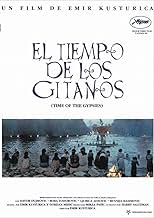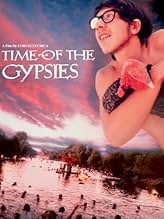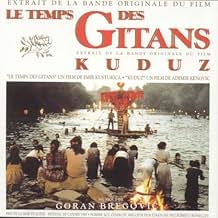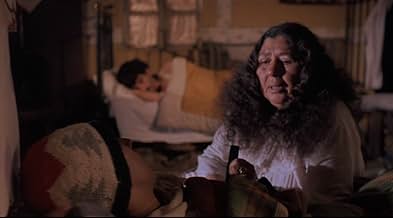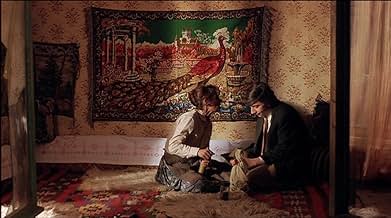AVALIAÇÃO DA IMDb
8,1/10
34 mil
SUA AVALIAÇÃO
Neste brilhante conto, que acontece aos redores da cidade de Saraievo na Itália, Perhan, um determinado jovem cigano com poderes telecinéticos, é seduzido pelo dinheiro fácil do mundo do cri... Ler tudoNeste brilhante conto, que acontece aos redores da cidade de Saraievo na Itália, Perhan, um determinado jovem cigano com poderes telecinéticos, é seduzido pelo dinheiro fácil do mundo do crime, que ameaça destruir a ele e a todos que ama.Neste brilhante conto, que acontece aos redores da cidade de Saraievo na Itália, Perhan, um determinado jovem cigano com poderes telecinéticos, é seduzido pelo dinheiro fácil do mundo do crime, que ameaça destruir a ele e a todos que ama.
- Direção
- Roteiristas
- Artistas
- Prêmios
- 3 vitórias e 5 indicações no total
- Direção
- Roteiristas
- Elenco e equipe completos
- Produção, bilheteria e muito mais no IMDbPro
Avaliações em destaque
'Time of the Gypsies' is a big, full movie.
It is full in the way a magic realism novel is full, with its intergenerational cast of characters; its vivid sense of place, the weather and community life, where private is always public, where joy and tragedy are inextricable; where magic, dream and delusion are indistinguishable.
It is full in the Fellini sense, with its grand, often hallucinatory, set pieces; its profusion of grotesques; its bursting compression of many plots; its general noisiness.
It is one film containing many simultaneous films (a gangster film; a surreal road movie; a romantic comedy; a rites-of-passage; a Christian allegory).
It somehow feels a little thin, like a tapestry of chunks from a massive novel. It is certainly a prime example of retrospective dating - at the time it seemed a masterpiece; over a decade on, it's pastiche Kusturica.
It is full in the way a magic realism novel is full, with its intergenerational cast of characters; its vivid sense of place, the weather and community life, where private is always public, where joy and tragedy are inextricable; where magic, dream and delusion are indistinguishable.
It is full in the Fellini sense, with its grand, often hallucinatory, set pieces; its profusion of grotesques; its bursting compression of many plots; its general noisiness.
It is one film containing many simultaneous films (a gangster film; a surreal road movie; a romantic comedy; a rites-of-passage; a Christian allegory).
It somehow feels a little thin, like a tapestry of chunks from a massive novel. It is certainly a prime example of retrospective dating - at the time it seemed a masterpiece; over a decade on, it's pastiche Kusturica.
I'm glad I was bored on a Friday night and decided to browse the foreign film section. I randomly picked Time of the Gypsies, and now it is my favorite. The soundtrack, as well as the movie, is amazing. This film is unique in almost every aspect. It was moving without being too gushy or fake--I highly recommend seeing it. The other commentees have said pretty much everything else about this film in an nicely eloquent way, so I feel I need not elaborate. :)
When I see a Kusturica film, I see the magic of Fellini but with a sinister edge. His characters may be crude and immorally incorrect, but interesting enough as an observation piece that represents the madness of life. All this done through an epic journey taken by the young and shy Perhan, who discovers the crudeness of live that alters his whole believes and existence. The film plays like an opera, but without the soap, making it another Kusturica masterpiece that mixes the real with the bizarre.
Dom za vesanje is not a movie that an average viewer can comprehend thoroughly, but this doesn't change the fact that it's a masterpiece. Emir Kusturica's storytelling requires some talent, intelligence, and flawless attention to follow and understand correctly, nonetheless it's absolutely unique and fantastic. I would never ever have thought I'd enjoy seeing the world through Yugoslavian gypsies' eyes, but it turned out to be possible so long as it's Kusturica who opens the window. Goran Bregovic's adorable tunes suit the movie perfectly fine too. This movie was one of those that strengthened my opinion which states European movies are a billion times better than American movies. Thanks to Kusturica and Bregovic for producing such a beauty. A perfect 10 for the cast as well.
In 1933 Spanish poet and theater director Federico Garcia Lorca gave a lecture in Buenos Aires titled "Play and Theory of the Duende" in which he addressed the fiery spirit, the 'duende', behind what makes great performance stir the emotions: "The duende, then, is a power, not a work. It is a struggle, not a thought. I have heard an old maestro of the guitar say, "The duende is not in the throat; the duende climbs up inside you, from the soles of the feet.' Meaning this: it is not a question of ability, but of true, living style, of blood, of the most ancient culture, of spontaneous creation."
So okay, Kusturica has mostly come and gone by now. But for a while he really tapped into a valuable duende. I don't know how much of that translates overseas as anything more than feisty craziness, but for those of us here at least he stirred passions that go back in time. He communicated something of the very fabric of our world.
So yes, a living style. Spontaneous creation. Meaning an exaggerated depiction; but one rooted in a recognizable reality, in ancient culture. Reckless people, who consume their beings with spontaneous love or song; the Balkans, meant broadly as a peoples whose common life and toll under Ottoman rule brought them so close, wrote ourselves into this worldview long before Kusturica. Like Goran Bregovic collected old folk songs into new renditions for these films, Kusturica merely translated into cultural images. But oh so well.
Τhis is why Kusturica really spoke to common people here. He reminded them, yes with so much feisty craziness, about a struggle - not a thought - about a life they instinctively have known from blood; so hard that sometimes it makes the eyes well up with tears of joy. About a woe so deep it can only be expressed with dance or a burning cigarette to the arm. About something inexplicable that turns the soul upside down.
Two paths in life then as I see it, both valuable; we should strive to be either Zorbas or Buddhas. That is to say, to either grasp life till it hurts or dispassionately let go. It's about living life fully in the flow of it, and we either vigorously swim or we observe how it all flows away. Everything else is really half-assed stuff, merely trying to stay afloat. Kusturica made films about Zorbas.
All this is well. But if we have perhaps invested part of ourselves in cinema, the images behind, Kusturica, especially here, is a real joy to behold. There was Tarkovsky, who inspired him so much; his stare was austere like those lean Christs we find in Orthodox icons. With Kusturica, Tarkovsky's camera becomes magical song, embodying with ardor of life the joyous sadness of a world turned upside down - so much in the film is about things askew, a house suspended in the air, a man hanging himself from a bell, the image of an inverted Christ in the end.
So one masterful touch is the cinematic flow. The other is how the flow encompasses an entire life; we have a kid who grows up to see how everything in life breaks, a grownup - as this kid - who has already resigned himself to the fact and is broken himself beyond salvation, a young mother who gives birth and dies like the dead mother who is only hearsay now, a second Perhan who will grow up with only hearsay of that young mother but with a father who came back to him. Fascinating stuff, most importantly because the symbolism is not a full circle, neat, precise, but messy, rugged with life.
This is good stuff. It is just not-important enough - in the academic sense - to be really beautiful, and just incomplete enough to allow ourselves to pour into it.
So okay, Kusturica has mostly come and gone by now. But for a while he really tapped into a valuable duende. I don't know how much of that translates overseas as anything more than feisty craziness, but for those of us here at least he stirred passions that go back in time. He communicated something of the very fabric of our world.
So yes, a living style. Spontaneous creation. Meaning an exaggerated depiction; but one rooted in a recognizable reality, in ancient culture. Reckless people, who consume their beings with spontaneous love or song; the Balkans, meant broadly as a peoples whose common life and toll under Ottoman rule brought them so close, wrote ourselves into this worldview long before Kusturica. Like Goran Bregovic collected old folk songs into new renditions for these films, Kusturica merely translated into cultural images. But oh so well.
Τhis is why Kusturica really spoke to common people here. He reminded them, yes with so much feisty craziness, about a struggle - not a thought - about a life they instinctively have known from blood; so hard that sometimes it makes the eyes well up with tears of joy. About a woe so deep it can only be expressed with dance or a burning cigarette to the arm. About something inexplicable that turns the soul upside down.
Two paths in life then as I see it, both valuable; we should strive to be either Zorbas or Buddhas. That is to say, to either grasp life till it hurts or dispassionately let go. It's about living life fully in the flow of it, and we either vigorously swim or we observe how it all flows away. Everything else is really half-assed stuff, merely trying to stay afloat. Kusturica made films about Zorbas.
All this is well. But if we have perhaps invested part of ourselves in cinema, the images behind, Kusturica, especially here, is a real joy to behold. There was Tarkovsky, who inspired him so much; his stare was austere like those lean Christs we find in Orthodox icons. With Kusturica, Tarkovsky's camera becomes magical song, embodying with ardor of life the joyous sadness of a world turned upside down - so much in the film is about things askew, a house suspended in the air, a man hanging himself from a bell, the image of an inverted Christ in the end.
So one masterful touch is the cinematic flow. The other is how the flow encompasses an entire life; we have a kid who grows up to see how everything in life breaks, a grownup - as this kid - who has already resigned himself to the fact and is broken himself beyond salvation, a young mother who gives birth and dies like the dead mother who is only hearsay now, a second Perhan who will grow up with only hearsay of that young mother but with a father who came back to him. Fascinating stuff, most importantly because the symbolism is not a full circle, neat, precise, but messy, rugged with life.
This is good stuff. It is just not-important enough - in the academic sense - to be really beautiful, and just incomplete enough to allow ourselves to pour into it.
Você sabia?
- CuriosidadesThe first feature to be filmed with its entire dialogue in the Gypsy language, Romany.
- ConexõesFeatured in Horrible Reviews: Best Movies I've Seen In 2021 (2022)
Principais escolhas
Faça login para avaliar e ver a lista de recomendações personalizadas
- How long is Time of the Gypsies?Fornecido pela Alexa
Detalhes
- Data de lançamento
- Países de origem
- Idiomas
- Também conhecido como
- Time of the Gypsies
- Locações de filme
- Sutka, North Macedonia(most of the film)
- Empresas de produção
- Consulte mais créditos da empresa na IMDbPro
Bilheteria
- Faturamento bruto nos EUA e Canadá
- US$ 280.015
- Tempo de duração2 horas 22 minutos
- Cor
- Proporção
- 1.85 : 1
Contribua para esta página
Sugerir uma alteração ou adicionar conteúdo ausente

Principal brecha
By what name was Vida Cigana (1988) officially released in India in English?
Responda


